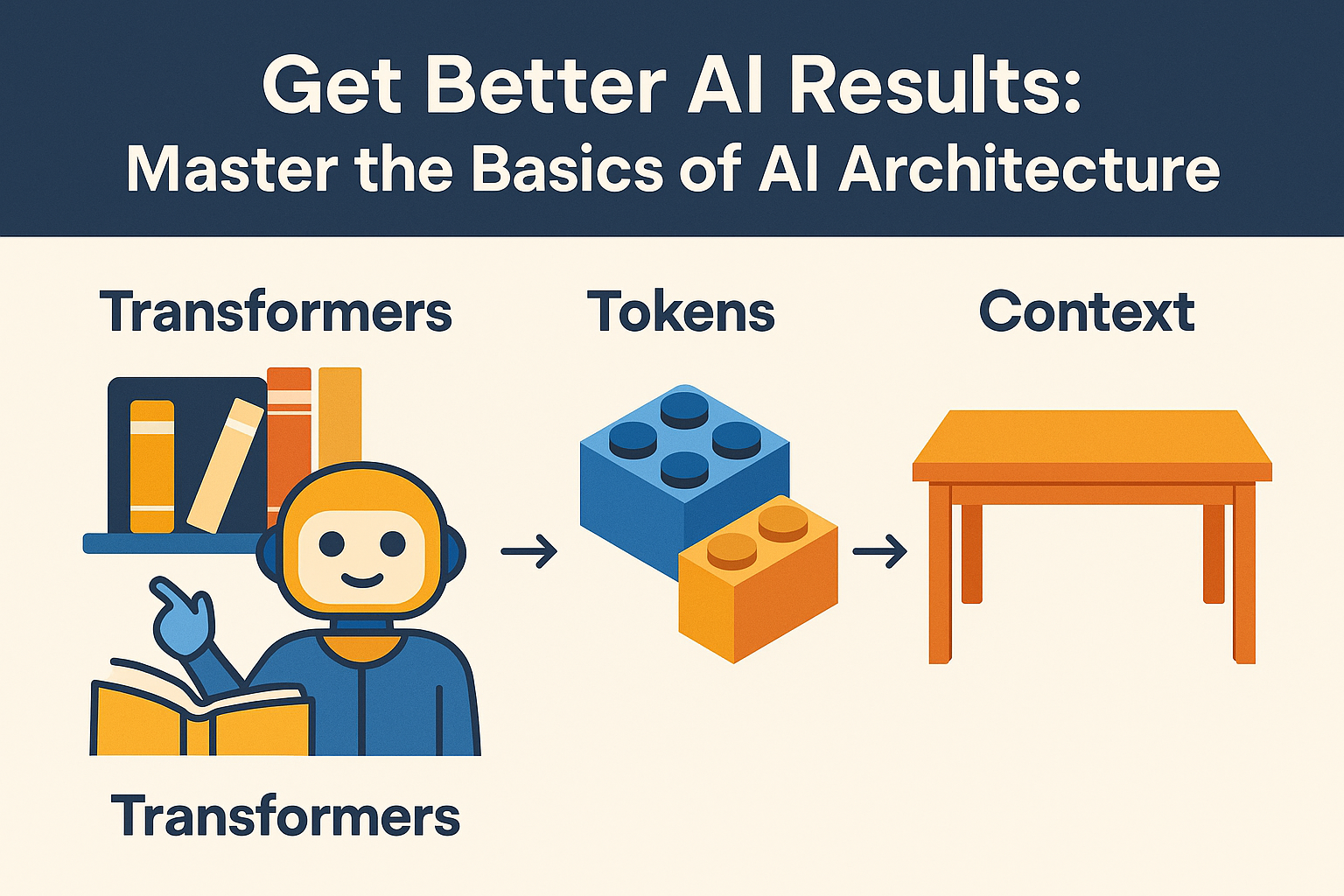When you hear terms like transformers, tokens, and context length, it may feel like AI is reserved for researchers. But in reality, these concepts explain why GPT-5, Claude, and Gemini all feel slightly different when you use them. Understanding AI architecture helps you pick the right tool for your work, even if you never write a line of code.
👉 If you’re brand new, start with ChatGPT for Beginners: 7 Easy Ways to Boost Productivity with AI.
👉 For more advanced prompting skills, check 7 Proven ChatGPT Techniques Every Advanced User Should Know.
First, What Is an AI Model?
Think of an AI model as:
- A recipe → trained on massive amounts of data (ingredients), guided by algorithms (instructions), producing responses (the meal).
- Or an engine → fueled by data, built to process patterns, and output power in the form of text, code, or images.
Different models (GPT, Claude, Gemini, LLaMA) are like different car engines — some prioritize speed, others efficiency, others versatility.
👉 For a deeper breakdown, see How to Understand AI Models Without the Jargon.
Transformers: The Brain of Modern AI
Most modern AI tools – from ChatGPT to Google Gemini – use something called transformer architecture. Think of transformers as the difference between reading a book page by page versus being able to see the entire story at once.
The Old Way: Sequential Processing
Earlier AI systems processed information sequentially, like reading a sentence word by word from left to right. If you asked about “the dog” mentioned at the beginning of a paragraph, the AI might have “forgotten” it by the end.
The Transformer Way: Attention Mechanism
Transformers introduced something called the “attention mechanism.” Imagine you’re at a party trying to follow multiple conversations. Your brain naturally focuses on (pays attention to) relevant parts while filtering out background noise. Similarly, transformers can “attend to” different parts of text simultaneously, understanding relationships between words regardless of their position.
This breakthrough explains why modern AI tools can maintain context better and provide more coherent responses. When you reference something from earlier in your conversation, the transformer architecture helps the AI “remember” and connect those dots.
🔤 Tokens: The Lego Blocks of Language
AI doesn’t read text as words but as tokens (chunks of characters).
- Example: “Chatbot” might become “Chat” + “bot” (two tokens).
- Tokens are like Lego bricks — the AI snaps them together to build sentences.
- That’s why models have token limits (like GPT-4’s 128k tokens or Claude Sonnet 4’s 1M tokens).
The more tokens a model can handle, the bigger the conversation or document it can “remember” at once.
👉 Related: Claude Sonnet 4’s million-token context is reshaping how AI handles long documents.
Context Length: AI’s Working Memory
If tokens are Lego bricks, context length is the size of the table you’re allowed to build on.
- A small table (say 8k tokens) means you can only build small structures.
- A massive table (1M tokens) lets you build skyscrapers — entire books, codebases, or research projects in one go.
This explains why Claude often outperforms others in long research tasks, while Gemini shines with real-time updates and multimodal input.
📊 Why Architecture Differences Matter
| Concept | Analogy | Why It Matters for You |
|---|---|---|
| Transformers | Librarian scanning all pages at once | Faster, more accurate results |
| Tokens | Lego blocks of language | Explains why long words take more space |
| Context Length | Size of the building table | Defines how much text or data AI can “hold in mind” |
👉 For hands-on examples, see Prompt Chaining Made Easy: Learn with Real-World Examples.
Real-World Impact
- Writers: A bigger context window means AI can edit entire drafts instead of just paragraphs.
- Students: Longer memory allows AI tutors to work with full textbooks.
- Businesses: Workflow automation improves when the model can “remember” past steps across thousands of lines of data.
👉 See how this plays out in workflows: How to Build Complex Workflows with AI Copilots and Zapier.
Final Thoughts
AI architecture may sound intimidating, but with analogies like recipes, engines, Lego blocks, and memory tables, the concepts become clear.
You don’t need to understand the math behind transformers — but knowing how tokens and context length affect your experience helps you choose the right AI model for the job.



